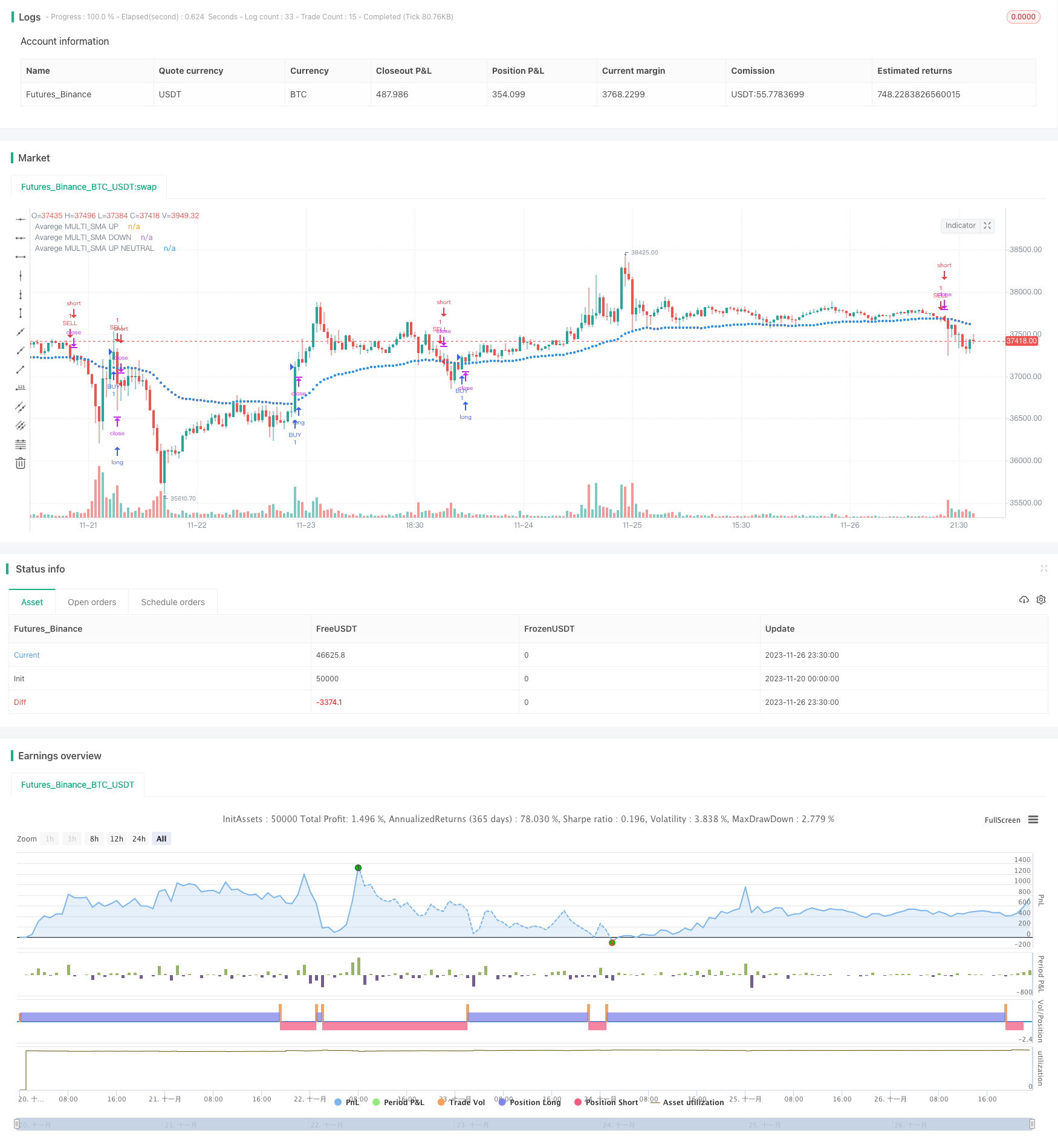
概述
该策略通过计算多时间段的SMA均线,并取平均值构建均线指标。当价格上涨突破均线时产生买入信号,当价格下跌突破均线时产生卖出信号,属于典型的均线交叉策略。
策略原理
- 计算5个不同周期(8日,21日,50日,100日,200日)的SMA均线
- 将5条均线值取平均,得到最终的均线指标
- 当收盘价上涨突破均线时,产生买入信号
- 当收盘价下跌突破均线时,产生卖出信号
该策略通过多时间段SMA的平均,能够有效平滑曲线,滤除假突破。与单一均线相比,具有更高的稳定性。
优势分析
- 使用多时间段均线能够有效滤除市场噪音,识别趋势
- 平滑曲线,避免产生大量假信号
- 策略逻辑简单清晰,容易理解实现,适合新手学习
- 可自定义均线周期组合,优化指标效果
风险分析
- 均线系统整体滞后,无法及时跟踪价格变化
- 突破失效时,停损点较远,亏损风险大
- 震荡趋势中,止损线被频繁触发
可以通过适当缩短部分均线周期,以及加入其他指标确认,来减小这些风险。
优化方向
- 优化均线周期组合,找到最佳参数
- 加入成交量等指标确认突破信号
- 结合趋势指标,避免震荡市场的虚假信号
- 开发自动参数优化程序,动态寻找最优参数
总结
该策略总体思路清晰,通过多时间段均线的集成,能够有效识别趋势,是一个稳定实用的策略。但我们也需要注意到其滞后性以及误报风险。通过进一步优化参数设定、加入确认指标等手段,可以持续改进该策略,使其成为一个强大的量化交易工具。
策略源码
/*backtest
start: 2023-11-20 00:00:00
end: 2023-11-27 00:00:00
period: 30m
basePeriod: 15m
exchanges: [{"eid":"Futures_Binance","currency":"BTC_USDT"}]
*/
//@version=3
strategy("STRATEGY AVERAGE MULTI_SMA", overlay=true)
sma1 = sma(close,input(title="SMA 1", defval=8))
sma2 = sma(close,input(title="SMA 2", defval=21))
sma3 = sma(close,input(title="SMA 3", defval=50))
sma4 = sma(close,input(title="SMA 4", defval=100))
sma5 = sma(close,input(title="SMA 5", defval=200))
mediaSMA= (sma1+sma2+sma3+sma4+sma5)/5
//color mediaSMA
MediaUP = mediaSMA>mediaSMA[1]
colorUP = (MediaUP ? #3CFF35 : na)
MediaDOWN = mediaSMA<mediaSMA[1]
colorDOWN =(MediaDOWN ? #FF0F03 : na)
colorN =(not MediaUP and not MediaDOWN and mediaSMA==mediaSMA[1] ? white : na )
plot(mediaSMA,title="Avarege MULTI_SMA UP", color=colorUP, style=circles, linewidth=2, transp=0)
plot(mediaSMA,title="Avarege MULTI_SMA DOWN", color=colorDOWN, style=circles, linewidth=2, transp=0)
plot(mediaSMA,title="Avarege MULTI_SMA UP NEUTRAL", color=colorN, style=circles, linewidth=2, transp=0)
//plot(sma1,color=blue,linewidth=1, style=line,transp=0,title="SMA 1")
//plot(sma2,color=yellow,linewidth=1, style=line,transp=0,title="SMA 2")
//plot(sma3,color=green,linewidth=1, style=line,transp=0,title="SMA 3")
//plot(sma4,color=purple,linewidth=1, style=line,transp=0,title="SMA 4")
//plot(sma5,color=red,linewidth=1, style=line,transp=0,title="SMA 5")
// Strategy
//BUY
comprar=close>mediaSMA and mediaSMA>mediaSMA[1]
fechar=close<mediaSMA and mediaSMA<mediaSMA[1]
strategy.entry("BUY",strategy.long,when=comprar)
strategy.entry("SELL",strategy.short, when=fechar)
//SELL
vender=close<mediaSMA and mediaSMA<mediaSMA[1]
fechar2=close>mediaSMA and mediaSMA>mediaSMA[1]
strategy.entry("SELL",strategy.short, when=vender)
strategy.entry("BUY", strategy.long,when=fechar2)